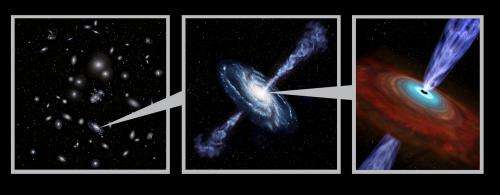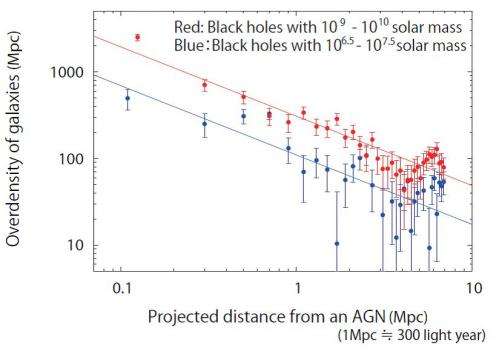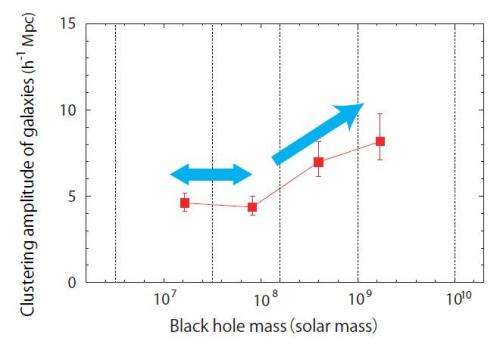Fat black holes grown up in cities: 'Observational' result using Virtual Observatory

Massive black holes of more than one million solar masses exist at the center of most galaxies. Some of the massive black holes are observed as active galactic nuclei (AGN) which attract surrounding gas and release huge amounts of energy.
How does a massive black hole get "fat"? One possibility is that mutual interaction between galaxies leads to the growth of a black hole. If this theory is correct, there must be some relationship between properties of an supermassive black hole and environment of its host galaxy. Previous studies revealed that radio-loud AGNs are in the overcrowded region. However, it is still not clear that relation between the mass of an central black hole and the environment around an active galaxy (galaxies hosting AGNs). This is why the research team explored the distribution of galaxies surrounding active galaxies.
The research team utilized the "Virtual Observatory" to examine many massive black holes and the environment of active galaxies.
The Virtual Observatory is a system to make integrated use of various astronomical databases around the world via sharing over the Internet. The Astronomy Data Center of NAOJ has been developing an original portal site for the virtual observatory. To begin with this research, the team collected the data on more than 10,000 AGN whose black hole mass had been already measured by spectroscopic observation with SDSS. Next, data on galaxies surrounding active galaxies were gathered from galaxy catalogues of UKIDSS; the number of galaxies reached approximately 70 million. Using the virtual observatory, the team could automatically and efficiently extract only necessary galactic data from the large amount of data sets on those galaxies surrounding active galaxies. In addition, they developed new analysis method in order to obtain the density distribution of galaxies with a high degree of accuracy.

The results show that the more massive black holes tend to be located in galactic environments with higher density. This connection between a massive black hole and the environment of its host galaxy is quite surprising since the radius of the overdense region of galaxies is 100 million times larger than the radius of a massive black hole.
Galaxy mergers frequently occur in regions where density of galaxies is high. The collision and merger of galaxies change gas dynamics within them, and can trigger the gas infall to their central region, leading to the growth of the black hole. Furthermore, when both merging galaxies have their own black holes, both black holes may merge together to become an even more massive black hole.
On the other hand, a very unexpected characteristic, even for the research team, was also found; in regards to massive black holes with a solar mass of 100 million or less, there is no correlation between the black-hole mass and the galaxy distribution. This suggests that there is a possibility that the growth process may be different between black holes above or below 100 million solar masses.

"Through this research, we have rediscovered the real potential of the virtual observatory, which can process such a huge amount of data in a very short time," said Komiya.
The research method via the virtual observatory can be applied to research using larger amounts of observation data, such as that captured by the new wide-field cameras of Subaru Telescope. Yuji Shirasaki, one of the research team members, talked about future research prospects, saying, "A large part of the total picture, such as the formation mechanism of relatively small massive black holes, still remains unknown; one of the reasons is the lack of observation. There are a lot of things to explore, including the mystery of how massive black holes are born."
More information: Komiya et al. A Cross-correlation Analysis of Active Galactic Nuclei and Galaxies Using Virtual Observatory: Dependence on Virial Mass of Supermassive Black Hole, Astrophysical Journal, vol.775, article id.43. iopscience.iop.org/0004-637X/775/1/43
Journal information: Astrophysical Journal
Provided by Japanese Virtual Observatory




















